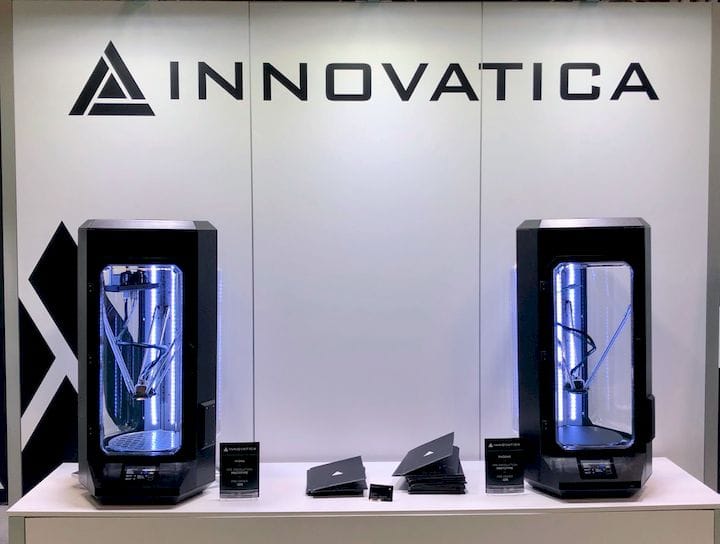![Innovatica’s delta-style 3D printers [Source: Fabbaloo]](https://fabbaloo.com/wp-content/uploads/2020/05/image-asset_img_5eb08f16170c8.jpg) Innovatica’s delta-style 3D printers [Source: Fabbaloo]
Innovatica’s delta-style 3D printers [Source: Fabbaloo]
We had a close look at a pair of powerful delta-style 3D printers from Innovative.
Innovatica is yet another 3D printing company from Poland, a country well-known for producing endless streams of new 3D print ventures. The privately-funded company produces one of the most unusual delta-style 3D printers we’ve yet seen.
While the two Innovatica devices, the Hydra and Phoenix, may seem like typical delta 3D printers, they are not. The story begins with Innovatica’s origins as a provider of 3D print services in Poland.
Like many such operations, they found many challenges with the 3D printers they used to produce customer products. In many cases, they had to repair the devices and this proved the key to the design of the Innovatica 3D printers.
Innovatica Easy Repairs
![Magnetic links on the Innovatica 3D printers [Source: Fabbaloo]](https://fabbaloo.com/wp-content/uploads/2020/05/image-asset_img_5eb08f165ad6c.jpg) Magnetic links on the Innovatica 3D printers [Source: Fabbaloo]
Magnetic links on the Innovatica 3D printers [Source: Fabbaloo]
One of the key features of the machines is that they are indeed highly repairable.
For example, almost everything is magnetically attached, such as these delta arm joints. Most of the machine is made from easily replaceable modules.
![Lowered mechanism in the Innovatica 3D printer for easy access [Source: Fabbaloo]](https://fabbaloo.com/wp-content/uploads/2020/05/image-asset_img_5eb08f1692c63.jpg) Lowered mechanism in the Innovatica 3D printer for easy access [Source: Fabbaloo]
Lowered mechanism in the Innovatica 3D printer for easy access [Source: Fabbaloo]
In this image we see the extruder mechanism being lowered for easy access.
These 3D printers are pretty robust, having been constructed from high-grade components obtained from both China and Europe.
There are several interesting features of the Hydra and Phoenix 3D printers. First, they are enclosed delta machines, an atypical configuration for that style of device. The dimensions are cylindrical, with a 300mm diameter and 300mm height. Most delta machines are large and open, causing potential print quality issues due to varying thermal conditions.
That’s not the case with the Innovatica devices, as their build chamber is enclosed — and brightly illuminated. This should increase print quality as the captured heat will decrease the thermal gradients.
High-Temperature Innovatica
![The Innovatica 3D printer printhead [Source: Fabbaloo]](https://fabbaloo.com/wp-content/uploads/2020/05/image-asset_img_5eb08f16d9459.jpg) The Innovatica 3D printer printhead [Source: Fabbaloo]
The Innovatica 3D printer printhead [Source: Fabbaloo]
About that heat, the Hydra sports a very high-temperature nozzle: up to 450C!
We’re told the company will soon enable temperatures up to 500C, a very high print temperature. Due to this very high temperature, the extrusion mechanism includes liquid cooling to ensure the heat doesn’t creep back up the filament path.
![The print plate on Innovatica 3D printers, which use a vacuum system [Source: Fabbaloo]](https://fabbaloo.com/wp-content/uploads/2020/05/image-asset_img_5eb08f172a6fc.jpg) The print plate on Innovatica 3D printers, which use a vacuum system [Source: Fabbaloo]
The print plate on Innovatica 3D printers, which use a vacuum system [Source: Fabbaloo]
Another interesting feature is the print surface. Here you can see a rather strange metal surface. This isn’t the actual print surface, as it’s not particularly flat. What really happens is that there is a specialized plastic sheet that fits over top of the metal plate, and a vacuum system holds it tightly down.
This approach is precisely what is used in Stratasys’ industrial Fortus systems, and it’s a very flexible approach (pun intended). It’s then possible to use different types of sheets to match the thermoplastic being 3D printed. Innovatica says they can provide sheets made from glass, Buildtak, PEI, PP, PET, Polyimide, and FR4 board.
Innovatica Materials
Innovatica provides a rather long list of possible materials for use in the machines, which includes many engineering materials.
![Color touchscreen control panel on the Innovatica 3D printers [Source: Fabbaloo]](https://fabbaloo.com/wp-content/uploads/2020/05/image-asset_img_5eb08f1779702.jpg) Color touchscreen control panel on the Innovatica 3D printers [Source: Fabbaloo]
Color touchscreen control panel on the Innovatica 3D printers [Source: Fabbaloo]
The other interesting implication here is that you can actually attempt to 3D print high-temperature materials such as ULTEM. The build chamber is actively heated (meaning not just stray heat from the hot end) to 80C, again, similar to the Fortus systems. Some other high-temperature 3D printers can achieve higher chamber heat, however.
There’s an onboard filament monitoring system that ensures you don’t run out of material. They explain:
“Printer precisely monitors the amount of used filament basing on extruder moves, and stores this data on NFC chip. Never wonder again how much filament you have left on spool, or what type of material it is. Just scan the NFC tag on the printer or using our smartphone app, and you will know all the details right away.”
Innovatica Safety Features
The machines includes a combination activated carbon and HEPAH13 filtration system that could make the devices much more suitable for office use, and certainly would remove any offensive odors.
There’s one terrific feature that should be included on any enclosed 3D printer, one I have not seen on other machines: chamber drying. When the 3D printer is not printing, it is possible to dry filament spools inside the build chamber by using the heating system.
Innovatica Pricing
We’re told the Phoenix is priced at £6,000 (US$) and the high-temperature Hydra is priced at £9,000 (US$). Currently they are accepting pre-orders, and expect to ship machines in January 2020.
Via Innovatica

